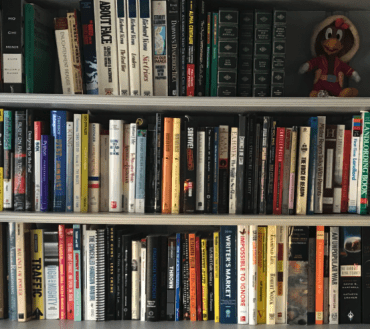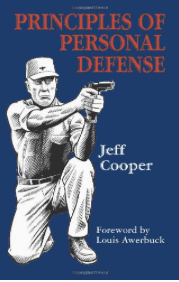
In 2002, the late Col. Jeff Cooper famously lamented the “decline of reading for pleasure” among the citizenry. “Not many people today read at all,” said he, “since they would rather look at the tube and allow some hired hand to edit their thoughts. And those who do read, do so mostly for self-improvement or general information.”
The Colonel wrote before smart phones with apps like Kindle and iBooks turned every cellphone into a library of the world’s classics, making his lament seem a tad pessimistic. Further, reading for information can, actually, be enjoyable if the writer is up to the task. Here’s short list of books that belong in the library of any gun owner who has decided to carry a firearm on a regular basis.
(1) Jeff Cooper, Principles of Personal Defense
[M]any men who are not cowards are simply unprepared for the fact of human savagery. They have not thought about it…and they just don’t know what to do. When they look right into the face of depravity or violence, they are astonished and confounded.
This can be corrected.
-Jeff Cooper
The late Jeff Cooper, founder of Gunsite Academy, wrote much on the subject of firearms, and even his off-the-cuff comments on news of the day in his newsletter (kids: people mailed out printed newsletters before blogs existed,) are examples of a master writer practicing his craft. If you read only one thing by the Colonel, however, it should be Principles of Personal Defense.
It’s not a difficult read; the book clocks in at barely eighty pages, and could easily be read entirely in an hour or two. In fact, it’s better to read the book slowly, a chapter every day, or even every week. It’s a book for contemplation, not about the nitty gritty of fighting, but instead about achieving the mindset that is a prerequisite for winning a fight.
And mindset, as the Colonel reminds us, is everything.
The victory of an explosive response by an obviously weaker party against superior force is easy to observe in the animal world. A toy poodle runs a German shepherd off his property. A tiny kingbird drives off a marauding hawk. A forty-pound wolverine drives a whole wolf pack away from a kill that the wolves worked hours to bring down. Aggressive carries with it an incalculable moral edge in any combat, offensive or defensive. And the very fact that the assailant does not expect aggresiveness in his victim usually catches him unawares.
This is definitely the first book to read for people new to concealed-carry. Indeed, its principles are universal enough to apply anywhere, at any time, regardless of whether one has a sidearm handy or not. The sidearm, as the Colonel might put it, is just a tool; the mind is the weapon.
(2) Massad Ayoob, In the Gravest Extreme: The Role of the Firearm in Personal Protection
Those of us who have seen violent death up close, who have seen what high-powered bullets can do to living human tissue, have a horror of inflicting that nightmarish, never forgotten damage on a fellow human being. Perhaps the only more terrifying prospect is that such a fate should befall us or our loved ones. This is why we, a representative cross-section of America’s population, keep deadly weapons for personal defense.
-Massad Ayoob
Massad Ayoob is highly sought-after gun rights advocate, trainer and expert witness for self-defense cases. He’s also a prolific writer, and has published books on everything from the nuts and bolts of concealed carry (The Gun Digest Book of Concealed Carry,) to dissections of historical gunfights involving both civilians and law enforcement officers (The Ayoob Files), to the current state of self-defense law (Deadly Force). They are all worth reading, but for me, Ayoob’s must-read book for people new to the concealed carry world remains his first one: In the Gravest Extreme, first published in 1980.
Why this one? Because it lays out the basic principles of both law and defensive gun uses without getting bogged down into details. Here, Ayoob writes about armed self-defense, beginning with the assumption that the reader is starting without any prior knowledge on the subject. He talks about basic legal principles that are generic enough to still pass muster today, and offers a healthy dose of anti-testosterone when it comes to things such as gun-safety and dealing with potential threat situations on the street.
True, a few parts of it are a little past their prime. The section on firearm and caliber selection, which were written in the prehistorical days before Gaston Glock created his 9mm plastic fantastic, and before the Bren Ten ushered in the era of the .40 S&W. The bit on women and guns caused more than a few chuckles from my lovely bride when she perused the book, too. But that doesn’t detract from the considerable qualities of the book, nor the fact that for someone just starting out, this is another must-read.
(3) Robert Cialdini, Pre-Suasion
No persuasive practice is going to work for sure whenever it is applied. Yet there are approaches that can consistently heighten the probability of agreement. And that is enough. A meaningful increase in those odds is enough to gain a decisive advantage….
Whether possessed of an inherent talent for influence or not, whether insightful about the methods or not, whether a gifted artisan of the language or not, it is possible to learn scientifically established techniques that allow any of us to be more influential.
-Robert Cialdini
At first blush, a book by an academic from Arizona who teaches psychology and marketing seems as though it has no direct application to to the world of firearms.
On another level, it absolutely does.
In our society today, the mere act of purchasing a firearm has acquired political significance. Just look at the increasingly shrill and desperate articles published in the past few years, which proffer statistics (of dubious credibility) that, when all is said and done, suggest that the number of gun owners in America is “only” 110,000,000 people. On the other end, NRA jefe Wayne LaPierre effectively putting the civil rights organization on the side of the right in the nation’s cultural wars. Merely mentioning that one owns firearms among acquaintances is almost guaranteed to provoke a political conversation.
By carrying a concealed firearm, you’re preparing yourself for armed combat because you think it might happen. Why wouldn’t you prepare yourself for the softer combat of words and influence that you know will happen?
Robert Cialdini has been rigorously studying the science of persuasion as long as men like Cooper and Ayoob have studied firearms. Cialdini has written extensively on six basic principles of influence in the past (reciprocation, social proof, consistency, liking, authority, and scarcity.) He talks about those principles in this book as well, but also on what he calls the “frontloading of attention” — and how little steps that have nothing to do with facts and logic, but everything to do with how humans feel can make the difference between failure and success in the persuasion game.
My favorite example is the one where a random group of fund-raisers in a call center who received a memo about a new campaign that had a photo of a runner winning a race had raised 60% more money than those who received the same instructions, but without the picture. Is this logical? Not in the slightest. Is stuff like this important to know? Absolutely.
Cialdini is an effective writer and easy to understand. This one isn’t as short as the others, but it is as every bit as rewarding and, in my opinion, necessary to those entering the gun world as the others.






The Law of Self Defense, 3rd Edition
Copyright © 2016 Andrew F. Branca
beat me to it.
Beat me to beating me to it! 8>)
Haven’t read it yet, though it’s on the list.
However, I deliberately excluded books that were talking about the nitty gritty of law, self-defense tactics, or anything else that could get one looking at the trees and not the forest.
Had read the other two, but not the Cialdini book. Sounds fascinating, and (as you mention) relevant to our interests.
Thanks!
That 3rd one….a student of Scott Adams Jedi mind tricks….
Negative, Ghost Rider. Adams is an acolyte of Cialdini’s, not the reverse.
Highly recommend the first two.
The 3rd seems to have nothing to do with concealed-carry (as in the post title) but much to do with politics.
Or more accurately – the marketing of a political agenda.
Spent some time in the Ag Legislative Group of our company (lobbying). We went through lots of training on how to “position” facts.
Not sure I want to mirror the political left in appealing to “feelz”. Tends to bite people of principle in the butt.
The left has no problem with it – at all.
Just my 0.02.
I hate to tell ya but both sides do it. I haven’t read that book but others like it are often fascinating, seeing what your unknown biases are is really interesting. If nothing else one on negotiations might be worth your while.
You should never give a number first, ever. But if you do…
Mr. Smith, how much do you think we should pay you?
A. Did you see twenty seven million people watched the elite 8? Golly. I’d like to be paid what I’m worth, no more, no less. I’ll work harder than anyone though and with good experience behind me I can be more productive too.
Statistically this actually works
Agreed that both sides do it.
Been through several negotiating classes. The most popular ones make you want to shower.
Neither here nor there for a concealed carry discussion – in my opinion.
i immediately related “presuasion” as useful in regards to diffusing developing, potentially violent situations.
I think trying to negotiate with a violent thug looking to do you harm is a quick ticket to the morgue.
Most negotiating starts with an understanding or respect between parties.
Do you think someone you might have to shoot has any respect for your ideas?
If i am in a situation which i think requires deadly force, I may shout commands.
I will not engage in conversation or listen to the attacker. If they don’t comply – I shoot.
Never a negotiation.
In a sense, you ARE negotiating with a thug. The negotiation is done with your actions and body language BEFORE he decides whether or not you’ll be his target today.
You have a desperate need to read Righteous Indignation by Andrew Breitbart.
Read the book, then decide. Your local library no doubt can get you a copy for free if you don’t want to pay.
I imagine that some of the information about how the mind and body react to the stress of combat in On Combat by Dave Grossman may be useful. The book is way longer than it needs to be and is a bit of a collection of information from other sources, but it certainly has pertinent information in it that I did not know before I read it.
The first two are definitely must read as is “No Second Place Winner” by Bill Jordan. https://www.amazon.com/Second-Place-Winner-William-Jordan/dp/0936279095
The first two are definitely must reads as is “No Second Place Winner” by Bill Jordan
I think it’s important to note that Robert Cialdini, a professor emeritus at Arizona State University, advised both the 2012 Obama presidential campaign and the 2016 Hillary Clinton presidential campaign.
And both campaigns convinced millions of people to vote for very flawed people. There is nothing wrong with using their techniques.
If you know the enemy and know yourself, you need not fear the result of a hundred battles.
If you know yourself but not the enemy, for every victory gained you will also suffer a defeat.
If you know neither the enemy nor yourself, you will succumb in every battle.
-Sun Tzu
I continue to highly recommend The Life-Giving Sword as an overall view on the philosophy of carrying a weapon or employing force of any type.
Nation of Cowards, by Jeff Snyder is right up there !
Deadly Force – Understanding Your Right to Self Defense – Massad Ayoob
The Gun Digest Book Of Concealed Carry – Massad Ayoob
And +1 on Branca’s book.
Deadly Force – Understanding Your Right to Self Defense – Massad Ayoob
The Gun Digest Book Of Concealed Carry – Massad Ayoob
And +1 on Branca’s book.
Comments are closed.